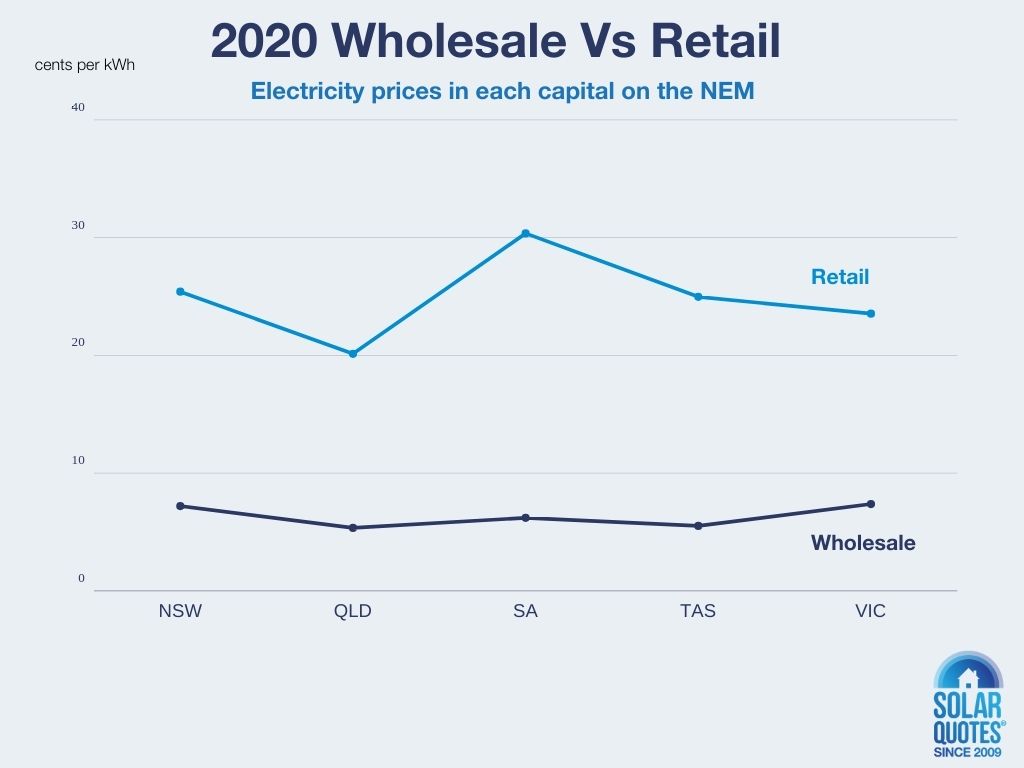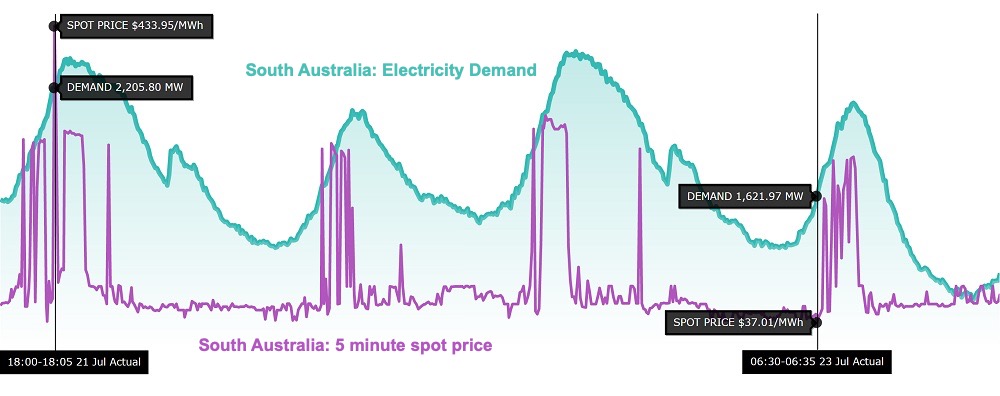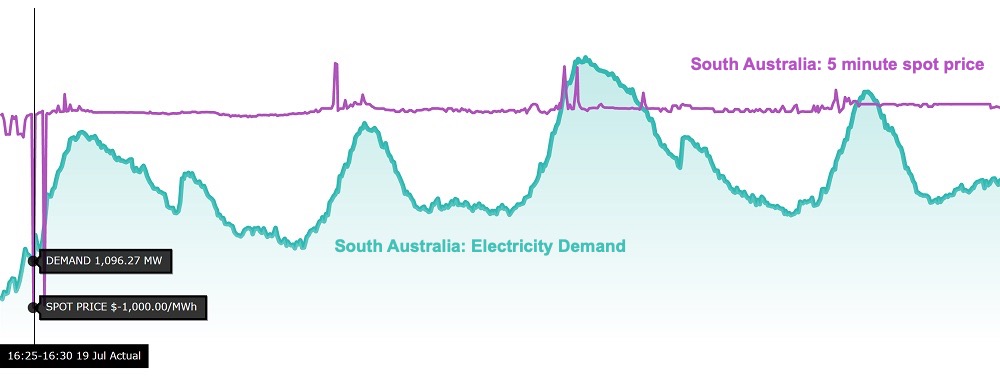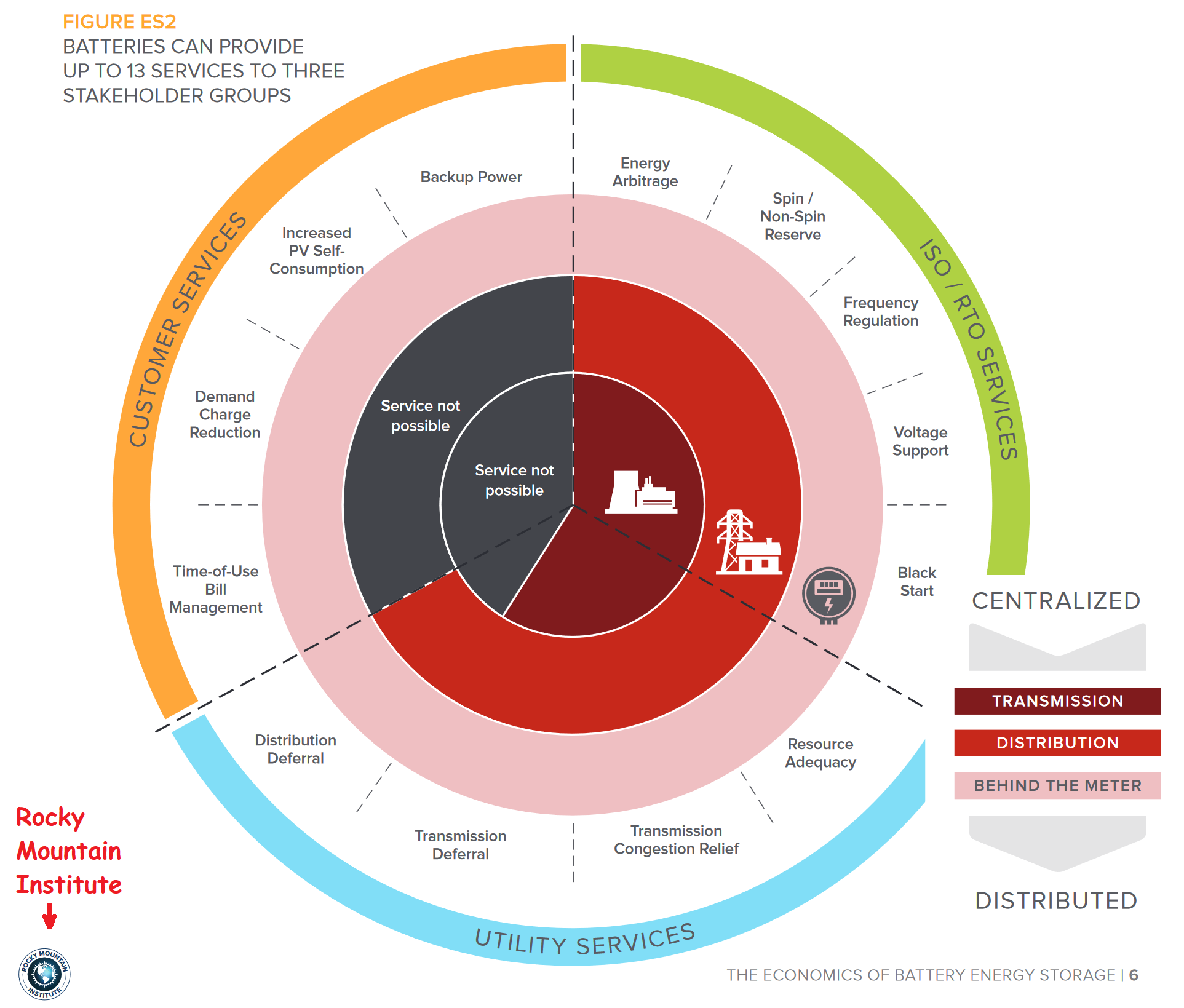
Around the same time, some commentators claimed residential solar power made no financial sense because large solar farms were cheaper. Sometimes they would go into a rant about how rooftop solar only existed because of subsidies. I never bothered to reply. I didn’t think it was worth the trouble, as the Australian internet was particularly primitive at the time. Our bearskins were still wrapped around live bears.
While these people seem to have disappeared from Australia,1 every now and then an American pipes up to tell us we’re doing it wrong.
And now some Australians are claiming the same about batteries. They insist home batteries make no sense because big-ass batteries, like the Tesla Big Battery in SA, are so much cheaper per-installed-kWh they’ll drive home batteries out of existence.
While it’s true big batteries can be built and maintained for less per-kWh, it is not true that they will out-compete home batteries forcing them out of the market. We will end up with a mix of large and small batteries and I predict, in the medium-term, most battery storage will be in homes, businesses, and vehicles.
There are two big reasons why big batteries won’t dominate:
- The difference between retail and wholesale electricity prices. Small-scale batteries are ‘Behind The Meter’, just like rooftop solar panels2. So when a building uses energy from its own battery it saves the retail price of electricity. Retail prices are, on average, much higher than the wholesale price of electricity. Big batteries can only earn wholesale prices for selling kilowatt-hours into the grid.
- A Behind The Meter battery can provide backup power to the property that is behind the same meter. If the grid goes down, having a big battery on the other end of the grid won’t help your home.
Because the Australian internet is now so advanced3 and capable of downloading dozens of cat pictures every day, I am now taking the opportunity to officially reply to people who insist big batteries will beat home batteries. As a bonus, my arguments will also apply just in case there is anyone still around who says rooftop solar power makes no sense because of large solar farms.
Wholesale Vs Retail
There are two4 ways solar farms can sell their electricity:
- Sell on the wholesale electricity market and receive whatever the market price is at the time.
- Have a Power Purchase Agreement (PPA) that pays a fixed price. Most solar farms have these. The amount is based on what wholesale prices are expected to be – weighted by expected output. This should be similar to the average price the solar farm would receive if it sold its output on the wholesale market, but without the uncertainty.
The average wholesale electricity price is far less than the retail price charged on your power bills:

The reason the retail price is much higher than the wholesale price is that it includes the wholesale price plus a heap of other costs. Here are the components of your electricity bill:
- Wholesale prices: Paying generators to provide electricity.
- Long-distance transmission: High voltage transmission lines used to move power long distances.
- Local distribution: Local electrical substations and poles and wires that provide electricity to homes and businesses.
- Metering: Installing and reading meters — reading meters is getting cheaper due to increasing use of meters smart enough to read themselves.
- Environmental Policies: The main one is our Renewable Energy Target that subsidises large scale solar and wind farms as well as small scale rooftop solar power. These subsidies are being phased out.5
- Retailing: Billing, sales, customer inquiries, devising devious new methods of confusing customers, etc.
Once everything else is added on, the wholesale price is only a modest slice of your bill.
When selling energy, a utility-scale battery will only receive the wholesale spot price, but when a home battery’s energy is used in the home (behind the meter) it saves the retail price of electricity.6
Time-Of-Use Tariffs
The retail charges on the previous chart are for standard tariffs, i.e a flat rate per-kWh. Time-of-use tariffs, which vary the per-kWh charge throughout the day, have the potential to increase the return from a home battery but are not as effective as some think. Usually, if a home has solar panels and no battery they are better off with a standard tariff, but if they get a battery they should definitely consider if they’d be better off changing to time-of-use.
Wholesale Electricity Prices Are Volatile
Wholesale electricity spot prices are volatile and can swing wildly. Here’s the 5-minute spot price for the South Australia wholesale electricity market over several days last week (July 2020). The maximum spot price of 43.395 cents per kilowatt-hour is shown, as well as the minimum of 3.701 cents:

These 5-minute prices aren’t what retailers pay for the energy they on-sell at retail rates. The actual price is the average of the 5-minute prices in a half-hour period. But on the first of July 2021, we will change to 5-minute settlement, so the purple line will become the actual wholesale spot prices. This will improve the return from batteries, but by then there will be enough battery capacity to considerably reduce the volatility in wholesale prices and this will reduce the amount of money that can be made.
But 5-minute settlement will still improve the return from home batteries that can buy and sell on the wholesale market via a Virtual Power Plant or VPP. VPPs could greatly improve the return from batteries, but they could also be used by retailers to rip people off, so be careful when signing up to one.
Wholesale Electricity Prices Can Be Negative
The maximum 5-minute price above is 43 cents per kilowatt-hour, but it can go as high as $23.50 per kilowatt-hour. This may occur during a severe heatwave or another critical event, such as a crapped out, old coal power station breaking down. But wholesale spot prices can also go negative, as this graph of SA wholesale prices starting on the afternoon of the 19th July 2020 shows:

While it may seem odd for prices to go negative,7 it occurs when too much electricity is being fed into the grid and has two advantages:
- Anyone directly exposed to spot prices will use as much electricity as they can because they will be paid to use it. This includes utility-scale batteries and home VPPs.
- It encourages generators to reduce output because they have to pay to generate.
The graph shows electricity prices hitting negative $10 per kilowatt-hour, the lowest price allowed. This means it’s technically possible for a battery to make $33.50 per kilowatt-hour on the wholesale market by charging at the maximum negative price and then selling at the maximum positive price. While this would return over 100x the typical retail price, it’s not easy in practice because after charging up at negative $10 per kilowatt-hour it might be months before it can be sold at the maximum wholesale price. But you don’t have to buy at the absolute minimum price and sell at the absolute maximum to play the game. The wholesale price of electricity is regularly far higher than the retail price.
A home battery can play the wholesale market by joining a Virtual Power Plant, but it’s also possible through an electricity retailer that passes through the real-time wholesale rate, such as those nice folk at Amber Electric.
Benefits Beyond Buying & Selling Electricity
Batteries can provide a whole stack of benefits beyond buying and selling electricity through what’s called “revenue stacking”.
The Rocky Mountain Institute, a sustainability organization in Americaland, has a graphic displaying 13 different services batteries can provide. See page six of this report.8 It divides batteries into three categories based on their location:
- Transmission: These are big grid batteries, typically located away from population centres. The Hornsdale Power Reserve in South Australia — or Tesla Big Battery as it’s often called — is an example.
- Distribution: These are used to support and provide services to local grids. They vary a lot in size but generally don’t come close to large utility-scale batteries.
- Behind the Meter: These are residential and commercial batteries such as an LG Chem RESU or Tesla Powerwall you might buy for your home or business.
Of the 13 services, only Behind the Meter batteries (the pink ring) can do them all, provided they participate in a suitable Virtual Power Plant.9

The 4 services that only Behind The Meter batteries can provide are:
- Backup Power
- Increased PV Self Consumption
- Demand Charge Reduction
- Time-of-use Bill Management
The first two are the main reasons people get home batteries — people like the idea of having power in a blackout and want to use their low-cost solar energy at night.
The third — Demand Charge Reduction — only applies to businesses that have to pay a demand charge based on the maximum amount of power they use. While there have been attempts to introduce demand charges for households, they haven’t caught on and I don’t approve of them because of the extra layer of complexity.
The final battery service — Time-of-use Bill Management — minimizes bills by discharging or reducing grid electricity consumption during peak times10.
When the value of these four services is considered, if home batteries can be installed at a low enough cost, utility-scale batteries will never stop them from being worthwhile. Even if we could build big batteries for just 1 cent per kilowatt-hour, it would still be economically worthwhile to pay to install Behind the Meter batteries in homes and businesses.
A Quick Example
If a home battery has the following characteristics:
- A standard tariff of 25 cents per kilowatt-hour.
- A solar feed-in tariff of 10 cents per kilowatt-hour.
- Round-trip efficiency of 90%.
- An average of 5 kilowatt-hours of grid electricity displaced each night11.
- The battery provides no benefit other than reducing electricity bills.
This would save an average of $1.25 a day, less the solar feed-in tariff that is forgone by charging it. With battery losses, the lost feed-in tariff would come to 50 cents for a total saving of 75 cents per day or $274 a year. Assuming a simple payback time under 7 years for the homeowner to consider it worthwhile, then if the battery could be installed for under $2,000 it will be worthwhile, no matter how cheap big grid batteries get.
While $2,000 is far cheaper than any installed 5 kWh+ battery available at the moment, many people will be happy to pay more when they consider the battery’s other benefits, such as buying and selling electricity on the wholesale market and backup power.
Unfortunately, even with these added benefits, home batteries are unlikely to pay for themselves at their current prices, with the possible exception of South Australia where there are hefty subsidies from both the government and VPP operators.
Batteries Will Benefit Everyone
Provided batteries fall enough in price, it will make sense to put them in homes no matter how cheap big batteries get. If a home battery can back up a home, earn credits from a VPP and save enough money on electricity bills, why wouldn’t people get one?
At the moment less than 1 in 100 Australian homes have batteries and far fewer are in Virtual Power Plants. But when we get to the point where 1 in 100 households have a modern home battery that is part of a VPP there will be a significant benefit to the grid. All those batteries will be able to provide as much power as a medium-sized power station. They can also absorb the same amount of power when renewable supply exceeds grid-demand.
When we get to the point where 1 in 20 or 1 in 10 homes have a battery system it will be a huge benefit when it comes to managing the grid.
This will help keep electricity prices down for everyone connected to the grid. It will also reduce any pressure to move from simple standard tariffs12 to more complex time-of-use tariffs, utterly confusing demand tariffs and other exasperating arrangements. This will help make Australia a happier and more relaxed country.
Large scale adoption will require batteries to fall in price, but I have no doubt this will happen. It’s just a matter of time. So far, it’s been a heck of a lot of time. But when I look at the relatively low cost of battery cells today and consider how far solar hardware has fallen in price over the years, I’m going to bet batteries become a heck of a lot cheaper over the next decade.Read more

















